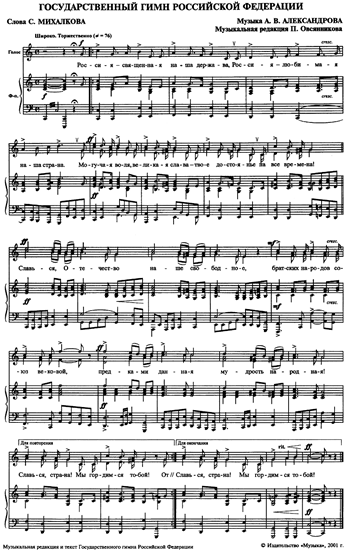All about the flag of the Russian Federation. The national anthem of the Russian Federation. Regional law "On the anthem of the Rostov region"

History of the Russian flag
On August 22, 1991, an emergency session of the Supreme Council of the RSFSR decided to consider official symbol Of Russia red-blue-white flag (tricolor) This day is celebrated in Russia as the State Flag Day of the Russian Federation.
The first flag of Russia was a red flag. Under the red banner, the teams of Prophetic Oleg and Svyatoslav went on campaigns.
![]()
The team of the Prophetic Oleg, storming Constantinople under the red banners
The flag under which Svyatoslav smashed Khazaria had an image of a two-prong on it. With the adoption of Christianity, the two-prong was replaced by a cross at Calvary. During the period of feudal fragmentation, each principality had its flag. The first attempt to introduce the all-Russian flag was a banner with the face of Christ. Under this flag, Dmitry Donskoy won.
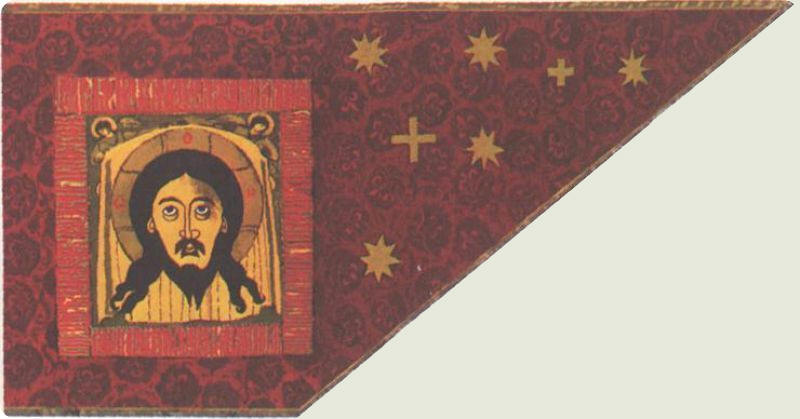
When Moscow princes began to collect Russian lands under their own hands, the Moscow Ezdets on the red field, which during the reign of Ivan III, gradually became the flag of united Russia replaced by a double-headed eagle borrowed from Byzantium on a white background.
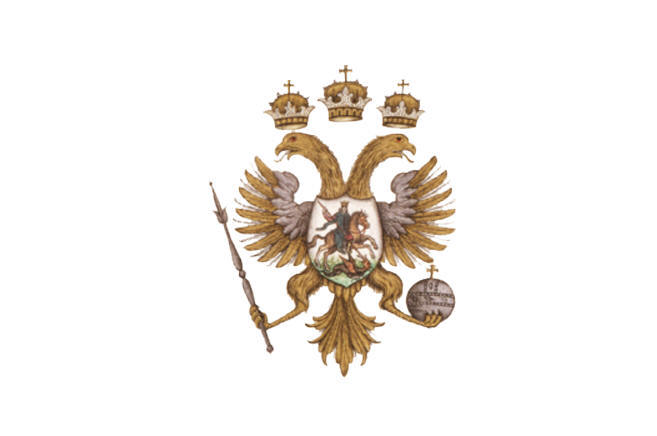
For the first time, a white-blue-red flag was hoisted on the first Russian warship Eagle, launched in 1667, which, however, three years later was burned by troops Stepan Razin.
What did this tricolor mean in those days? Surely you noted for yourself the fact that the appearance of the tricolor flag coincided with the unification of Russia that began: according to the Andrusovsky truce, which ended the victorious Russian-Polish war of 1654-67, left-bank Ukraine and a piece of the eastern part of White Russia departed to the Moscow kingdom. In commemoration of this event, a three-color flag was established, meaning the unity of Great, Lesser and White Russia.
Rightful father tricolorand now Peter I. is recognized on January 20, 1705, he issued a decree according to which "on all kinds of merchant ships" they should raise a white-blue-red flag, he drew a sample and determined the order of horizontal stripes.
Flag of the times of Alexei Mikhailovich

In different variations, the three-lane flag was also decorated with warships until 1712, when the St. Andrew flag was approved on the navy.

In 1858, Alexander painted a drawing “with the arrangement of the emblem's black-yellow-white colors of the Empire on banners, flags and other objects for decoration on the streets for special occasions”. And on January 1, 1865, a personal decree of Alexander II came out, in which the colors black, orange (gold) and white were directly called the "state colors of Russia." The black-yellow-white flag lasted until 1883.
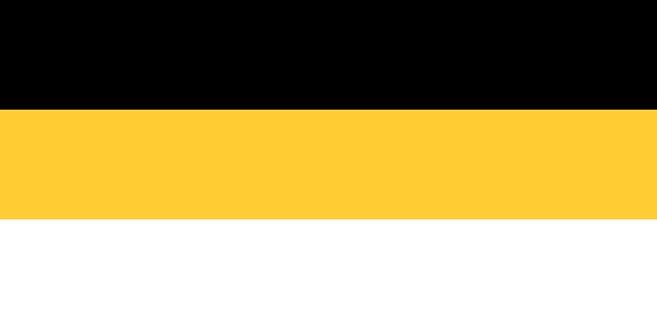
The national flag of the Russian Empire from June 11, 1858 to April 28, 1883
butOn April 28, 1883, the decree of Alexander III was announced, which said: “So that in those solemn occasions when it is considered possible to allow the decoration of buildings with flags, only the Russian flag should be used, consisting of three stripes: upper - white, middle - blue and lower - red flowers. " In 1896, Nicholas II established a special meeting at the Ministry of Justice to discuss the issue of Russian national flag. The meeting concluded that "the white-blue-red flag has every right to be called Russian or national, and its colors: white, blue and red are called state."
The last flag of the Russian Empire
Flag of the RSFSR from June 17, 1918 to January 21, 1937
The decree of the Presidium of the All-Russian Central Executive Committee of April 1, 1937 approved a new image national flag The RSFSR, developed on behalf of the Presidium of the All-Russian Central Executive Committee, by the artist A.N. Milkin. Unlike the RSFSR flag of the previous model, the new flag did not have a roof surrounded by gold lines, and the abbreviation of the name of the republic was plotted in ordinary font, without dividing points. On January 20, 1947, the Presidium of the Supreme Soviet of the USSR, by its resolution “On the State Flags of the Union Republics,” recognized it appropriate to amend the state flags of the Union SSR so that the state flags of the Union SSR reflect the idea of \u200b\u200bthe Union Soviet state and the national characteristics of the republics. The USSR emblem was placed on the flags - a sickle and a hammer with a red five-pointed star while maintaining the main red color of the panel, and in addition to the main red color of the panel, other colors were introduced, a national ornament was included. By a decree of the Presidium of the Supreme Council of the RSFSR of January 9, 1954, a new description of the state flag of the RSFSR was established: a red rectangular cloth with a light blue stripe at the flagpole over the entire width of the flag, which is one eighth of the flag's length. In the upper left corner of the red panel were depicted a golden sickle and a hammer and above them a red five-pointed star framed by a gold border. On August 22, 1991, the Extraordinary Session of the Supreme Council of the RSFSR decided to consider it an official symbol of Russia tricolorand by presidential decree of December 11, 1993, the Regulation on the State Flag of the Russian Federation was approved. And this is not accidental, because it is this tricolor developed over the heads of those who provided
Three colors of the flag, which became national, received an official interpretation. Red color meant "sovereignty", blue - the color of the Mother of God, under whose cover is Russia, white - the color of freedom and independence. These colors also meant the community of White, Small and Great Russia. After the February Revolution, the Provisional Government used the white-blue-red flag as the state. Soviet Russia did not immediately reject the tri-color symbol of Russia. On April 8, 1918, Ya.M. Sverdlov, speaking at a meeting of the Bolshevik faction of the All-Russian Central Executive Committee, proposed to approve the combat red flag with the national Russian flag, and for more than 70 years the red flag has been the state flag. 
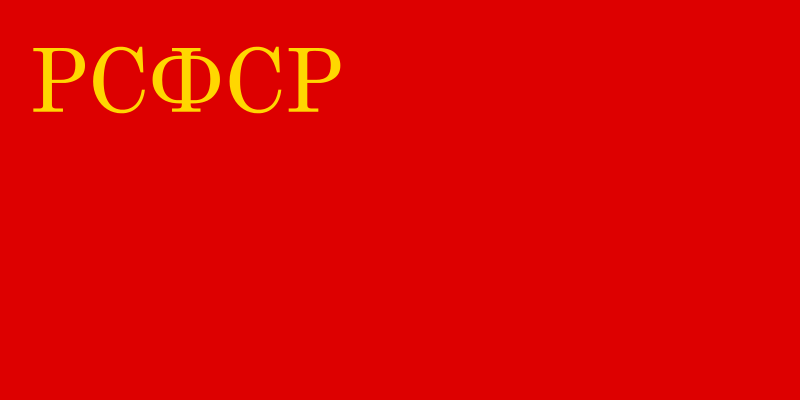


Flag with a blue stripe that existed as the flag of the RSFSR from November 1, 1991 to December 25, 1991 and the Russian Federation until December 11, 1993
In 1994, Russian President Boris Yeltsin signed a decree stating: “In connection with the restoration on August 22, 1991 of the historical Russian tricolor state flag covered with the glory of many generations of Russians, and in order to educate current and future generations of Russian citizens with respect for state symbols, I decide: To establish a holiday - the Day of the State Flag of the Russian Federation and celebrate it on August 22nd. ” On December 25, 2000, Russian President Vladimir Putin signed the Law, according to which the State Flag of Russia is a rectangular panel of three equal horizontal stripes: the upper — white, middle — blue and red.

State Flag Day of the Russian Federation
Every year on August 22, Russia celebrates the State Flag Day of the Russian Federation, established on the basis of Decree of the President of the Russian Federation No. 1714 of August 20, 1994 “On the Day of the State Flag of the Russian Federation”.
On August 22, 1991, the tricolor Russian flag was officially raised for the first time over the White House in Moscow, replacing the red cloth with a sickle and a hammer as a state symbol.
Story:
The national flag in Russia appeared at the turn of the XVII-XVIII centuries, in the era of the emergence of Russia as a powerful state. For the first time, a white-blue-red flag was hoisted on the first Russian warship Eagle, during the reign of the father of Peter I Alexei Mikhailovich. The “Eagle” did not sail for a long time under a new banner: having descended the Volga to Astrakhan, it was burned there by the rebellious peasants Stepan Razin. Peter I was recognized as the legal father of the tricolor on January 20, 1705, according to which a white-blue-red flag should be hoisted on all kinds of merchant ships, he himself drew a pattern and determined the order of horizontal stripes.
In different variations three-lane flag decorated and warships until 1712when the St. Andrew’s flag was established on the navy. In 1858, Alexander II approved the drawing "with the arrangement of the emblem's black-yellow-white flowers on the banners, flags and other objects for decoration on the streets for special occasions." BUT January 1, 1865 a personal decree of Alexander II was issued, in which colors black, orange (gold) and white already right called "state colors of Russia." The black-yellow-white flag lasted until 1883. April 28, 1883 an order was issued by Alexander III, which said: “So that in those solemn occasions when it is considered possible to allow the decoration of buildings with flags, only the Russian flag should be used, consisting of three stripes: upper — white, middle — blue and lower — red.” In 1896, Nicholas II established a Special Meeting at the Ministry of Justice to discuss the issue of the Russian national flag. The meeting concluded that "the white-blue-red flag has every right to be called Russian or national, and its colors: white, blue and red are called state." Three colors of the flag, which became national, received an official interpretation. Red color meant "sovereignty", blue - the color of the Mother of God, under whose cover is Russia, white - the color of freedom and independence. These colors also meant the community of White, Small and Great Russia.

August 22, 1991 Extraordinary session of the Supreme Council of the RSFSR decided to consider the official symbol of Russia is the tricolorand by decree of the President of the Russian Federation of December 11, 1993, the Regulation on the State Flag of the Russian Federation was approved. In August 1994, Russian President Boris Yeltsin signed a decree stating: “In connection with the restoration on August 22, 1991 of the historical Russian tricolor state flag covered with the glory of many generations of Russians, and with the aim of educating the present and future generations of Russian citizens with respect state symbolsI decide: To establish a holiday - Day of the State Flag of the Russian Federation and celebrate it on August 22nd. ”
December 25, 2000 Russian President Vladimir Putin signed the Law, according to which the State flag of Russia is a rectangular panel of three equal horizontal stripes: the upper - white, middle - blue and lower - red.
The colors of the Russian flag are attributed many symbolic meanings. There is currently no official interpretation of the colors of the State Flag of the Russian Federation.
White, blue and red colors from ancient times in Russia meant:
- white color - nobility and frankness;
- blue color - fidelity, honesty, impeccability and chastity;
- red color - courage, courage, generosity and love.
The national flag in Russia appeared at the turn of the XVII-XVIII centuries, in the era of the emergence of Russia as a powerful state. For the first time, a white-blue-red flag was hoisted on the first Russian warship Eagle, during the reign of the father of Peter I Alexei Mikhailovich. It is known that the “Eagle” did not sail for a long time under a new banner: having descended the Volga to Astrakhan, it was burned by the rebellious peasants Stepan Razin. Peter I was recognized as the legal father of the tricolor on January 20, 1705, according to which a white-blue-red flag should be hoisted on all kinds of merchant ships, he drew a pattern and determined the order of horizontal stripes. In different variations, the three-lane flag was also decorated with warships until 1712, when the St. Andrew flag was approved on the navy.
In 1858, Alexander II approved the drawing "with the arrangement of the emblem's black-yellow-white flowers on the banners, flags and other objects for decoration on the streets for special occasions." And on January 1, 1865, a personal decree of Alexander II came out, in which the colors black, orange (gold) and white were directly called the "state colors of Russia."
The black-yellow-white flag lasted until 1883. On April 28, 1883, the decree of Alexander III was announced, which said: "So that in those solemn occasions when it is considered possible to allow the decoration of buildings with flags, only the Russian flag should be used, consisting of three stripes: upper - white, middle - blue and lower - red flowers. " Finally, in 1896, Nicholas II established a Special Meeting at the Ministry of Justice to discuss the issue of the Russian national flag. The meeting concluded that "the flag white-blue-red has the full right to be called Russian or national and its colors: white, blue and red are called state" and determined that the whole empire should "finally be considered white-blue-red, and no other. "
Three colors of the flag, which became national, received an official interpretation. Red color meant "sovereignty", blue - the color of the Mother of God, under whose cover is Russia, white - the color of freedom and independence. These colors also meant the community of White, Small and Great Russia.
After the February Revolution, the Provisional Government used the white-blue-red flag as the state. Soviet Russia did not immediately reject the tri-color symbol of Russia. April 8, 1918 Ya.M. Sverdlov, speaking at a meeting of the Bolshevik faction of the All-Russian Central Executive Committee, proposed to approve the combat red flag with the national Russian flag, and for more than 70 years the red flag has been the state flag.
The proposal to replace the “revolutionary” red flag with a white-blue-red one was expressed by Russian MP Viktor Yaroshenko - even before the August 1991 coup. The Extraordinary Session of the Supreme Council of the RSFSR on August 22, 1991 decided to consider the tricolor to be the official symbol of Russia, the Decree on the national flag of the Russian Federation was approved by Decree of the President of the Russian Federation of December 11, 1993, and the decree of August 20, 1994 established that the State flag is constantly on the buildings , which houses the Presidential Administration, federal executive bodies, other federal bodies of state power, bodies of state power of the constituent entities of the Russian Federation (together with flags with The object of the Russian Federation).
In August 1994, Russian President Boris Yeltsin signed a decree that said: "In connection with the restoration on August 22, 1991 of the historical Russian tricolor state flag covered with the glory of many generations of Russians, and in order to educate current and future generations of Russian citizens with respect to state symbols, I decide: To establish a holiday - Day of the State Flag of the Russian Federation and celebrate it on August 22 ".
In January 1998, it was decided to remove the problem of legislative consolidation of state symbols from the agenda of domestic political life, since there are polar points of view in this regard both in society and in parliament.
On December 4, 2000, Russian President Vladimir Putin introduced to the State Duma, among other laws on state symbols, a draft federal constitutional law "On the State Flag of the Russian Federation." On December 8, 2000, the State Duma adopted the bill in the first and third (final) readings. On December 20, 2000, the Federation Council of the Federal Assembly of the Russian Federation approved the draft law; on December 25, 2000, it was signed by Russian President Vladimir Putin.
In accordance with the law, the State flag of the Russian Federation is a rectangular panel of three equal horizontal stripes: the upper - white, middle - blue and lower - red. The ratio of the width of the flag to its length is 2: 3.
Currently, most often (unofficially) the following interpretation of the values \u200b\u200bof the colors of the flag of Russia is used: white means peace, purity, purity, perfection; blue - the color of faith and fidelity, constancy; red color symbolizes energy, strength, blood shed for the Fatherland.
STATE ANTHEM OF THE RUSSIAN FEDERATION
|
|
TEXT OF THE HYMN OF THE RUSSIAN FEDERATION 1st verse: Russia is our sacred power, Chorus: 2nd verse: From southern seas to the polar edge Chorus: Glory to our free Fatherland, 3rd verse: Wide scope for dreams and for life Chorus: Glory to our free Fatherland, |
For a long time in Russia there was no anthem. Until the seventeenth century, Orthodox church songs were performed during state ceremonies and events of national importance. In the era of Peter the Great, during all sorts of celebrations, “viva cantas” began to be performed - patriotic chants interspersed with the singing “Many summers”. They were performed until the 1780s.
Throughout the eighteenth century, the anthem performed the medieval pan-European anthem "We praise you, God." It was performed after the victories of the Russian troops, at the end of solemn prayers and in the "royal" days of the imperial family. The oldest Russian Transfiguration March of Peter the Great, which was created closer to the end of the reign of Peter, adjoined the laudations and oratorios.
By the end of the nineteenth century, the Transfiguration March became the main one in Russia. Since 1917, this march for some time served as the national anthem.
The first official national anthem of Russia was the “Prayer of the Russians” to the words of A.V. Zhukovsky - "God save the Tsar!" September 19, 1816 "Prayer" was sung during the celebration of the anniversary of the Tsarskoye Selo Lyceum with two additional verses composed by A.S. Pushkin. Then Alexander I issued a decree to perform the “Prayer of the Russians” by the regimental orchestra always at the meetings of the emperor.
The date of birth of the second official anthem of Russia - "God Save the Tsar" to the tune of A.F. Lviv - it was December 25, 1833, the day of the celebration of the anniversary of the expulsion of the French from Russia. This hymn existed until March 2, 1917, the day of the abdication of Emperor Nicholas II.
After the February Revolution of 1917, the Russian Marseillaise played the anthem for a short time. At the suggestion of V.I. Lenin "in the new conditions" of the "irreconcilable class struggle" instead of the "bourgeois" Marseillaise "began to use the" International. "January 10, 1918 at the Third Congress of Soviets, it was already performed as the anthem of the triumphant proletarian revolution.
On January 1, 1944, for the first time, the new national anthem “Union of the indestructible republics of the free” was sounded on the radio (music by A.V. Alexandrov, lyrics by S.V. Mikhalkov and G.A. El-Registan). By a decree of the Presidium of the Supreme Soviet of the USSR, the new anthem was approved from March 15, 1944 for widespread use.
In 1990, by decision of the Council of Ministers of the RSFSR, a government commission was formed in Russia to create a new national anthem (co-chairs are Sergei Mikhalkov, Minister of Culture of the Russian Federation Evgeny Sidorov, chairman of the Union of Composers of Russia Vladislav Kazenin). The authorities approved M.I.'s "Patriotic song" as his music. Glinka. A competition was announced for the text of the anthem. According to the terms of the contest, poems were accepted from all citizens of Russia.
The Decree of the President of the Russian Federation of December 11, 1993 approved the Regulation on the State Anthem of the Russian Federation, on the basis of which the State anthem of the Russian Federation is a melody created on the basis of the "Patriotic Song" by M.I. Glinka arranged by A. Petrov.
The commission for the preparation of the new anthem announced a competition for its text; in total, over 6,000 texts were received by the commission. After a long work, we stopped at twenty, which were recorded on tape by the choral collective. After listening to these texts, the commission members came to the conclusion that none of the options voiced is suitable for the national anthem of Russia. The work of the commission was discontinued in 1996.
In January 1998, President of the Russian Federation Boris Yeltsin submitted to the State Duma a federal constitutional law “On the State Flag, Coat of Arms and Anthem of the Russian Federation”. The State Duma rejected the law already in first reading on January 23, 1998. The State Duma also rejected an alternative project "On the State Anthem of the Russian Federation", submitted by the Communist Party faction and providing for a return to the anthem to the music of A. Alexandrov, the anthem of the USSR.
At a meeting of the top leaders of the legislative and executive powers - the Quartet - on January 29, 1998, it was decided that it is currently advisable to remove the problem of legislative consolidation of state symbols from the agenda of domestic political life, since there are polar points of view in society and in parliament on this account. The issue of state symbols will be referred to a special commission "for a thorough study and preparation of proposals."
On December 4, 2000, Russian President Vladimir Putin introduced the draft federal constitutional law “On the National Anthem of the Russian Federation” along with federal laws on state symbols. Alexandrov’s music was proposed as a hymn. On December 8, 2000, the State Duma adopted in the first and third (bypassing the second, which allows the State Duma regulations) readings a draft constitutional law "On the National Anthem of the Russian Federation." On December 25, 2000, President of the Russian Federation Vladimir Putin signed the federal constitutional law of the Russian Federation On the State Anthem of the Russian Federation, which entered into force on December 27, 2000.
In December 2000, a working group was formed to consider proposals for the text of the national anthem. Part working group in particular, St. Petersburg Governor Vladimir Yakovlev, Minister of Culture Mikhail Shvydkoy, Chairman of the Duma Committee on Culture and Tourism Nikolay Gubenko, a number of State Duma deputies and members of the Federation Council, as well as the Presidential Administration are included.
On December 30, 2000, Russian President Vladimir Putin signed a decree on the text of the national anthem of the Russian Federation. By decree, the President approved the text of the anthem, written by Sergei Mikhalkov.
In mid-January 2001, Vladimir Putin introduced the text of the State Anthem of Russia to the State Duma for consideration as a draft law "On Amendments and Additions to the Federal Constitutional Law" On the State Anthem of the Russian Federation.
On March 7, 2001, the State Duma adopted in the first, second and third, final reading, the bill introduced by the president on the text of the National Anthem to the words of Sergei Mikhalkov. On March 14, the bill was approved by the Federation Council, signed by President of the Russian Federation Vladimir Putin on March 22, 2001 No. 2 of the FKZ, and entered into force on March 24, 2001.
STATE EMBLEM OF THE RUSSIAN FEDERATION

The double-headed eagle as the emblem of the Moscow state first appeared on the seal of Ivan III in 1497 after his marriage to the Byzantine princess Sofya Paleolog: the image of the double-headed eagle (the coat of arms of Byzantium) was combined with the Moscow coat of arms, resulting in an eagle on one half of the coat of arms, and a horseman on the other trampling a dragon.
Subsequently, changes were made to the coat of arms. On the seals of Tsar Ivan IV the Terrible, the image of George the Victorious, the symbol of Moscow princes, began to be placed on the chest of the eagle. Since 1625, under Tsar Mikhail Fedorovich, three crowns appeared over the heads of the eagle. After the foundation of the Order of St. Andrew the First-Called by Peter the Great, a chain with the order sign was included in the coat of arms. Under Paul I, the image of the Maltese cross was also added to the coat of arms.
A large-scale reform of the coat of arms was carried out by Alexander I - in 1825 the state eagle was given not a heraldic, but a completely arbitrary form. This eagle had widely spread wings and held thunderbolts and a torch in the right paw, intertwined with ribbons, and a laurel crown in the left. The dynastic Andreev chain disappeared, and on the chest of the eagle appeared an unconventional (heart-shaped) shield, pointed up, with the Moscow coat of arms. Emperor Nicholas I already in 1830 returned to the traditional emblem, but supplemented it with the arms of the kingdoms that make up the Russian Empire. The shields of these emblems were located on the open wings of an eagle.
The reign of Alexander II was marked by a new reform of the coat of arms. It was a purely heraldic reform - the emblem's drawing was brought into line with the international rules of heraldry. In 1882, a strict hierarchy of the coat of arms was established - the Large, Medium and Small state emblems of the Russian Empire. From this time until February 1917, the image of the coat of arms becomes unshakable.
After the February Revolution of 1917, the imperial double-headed eagle, but without crowns, appeared on the press and banknotes of the Provisional Government. The decree of the All-Russian Central Executive Committee and the Council of People's Commissars of November 10, 1917 "On the destruction of estates and civil ranks" abolished the Russian insignia, orders, flag and coat of arms.
On November 5, 1990, the Government of the RSFSR adopted a resolution establishing the State Emblem and the State Flag of the RSFSR. A Government Commission was created to organize this work. After extensive discussion, the commission proposed recommending the Government a white-blue-red flag and coat of arms - a golden double-headed eagle on a red field. The final restoration of these symbols took place in 1993, when they were approved by the Decrees of President B. Yeltsin as the state flag and coat of arms: November 30, 1993, President of the Russian Federation B.N. Yeltsin signed the Decree "On the State Emblem of the Russian Federation." According to the Regulation on the coat of arms, it is “an image of a golden double-headed eagle placed on a red heraldic shield; above the eagle are three historical crowns of Peter the Great (above the heads are two small and above them are one larger); in the paws of the eagle are a scepter and orb "on the chest of an eagle on a red shield is a horseman striking a dragon with a spear."
On December 4, 2000, Russian President Vladimir Putin introduced the draft federal constitutional law "On the State Emblem of the Russian Federation" along with a number of bills on state symbols. A double-headed golden eagle against the background of a red shield was proposed as a coat of arms. On December 8, the State Duma adopted in the first and third (bypassing the second, which allows the State Duma regulations) readings a draft law "On the State Emblem of the Russian Federation." On December 25, 2000, President of the Russian Federation Vladimir Putin signed the federal constitutional law of the Russian Federation “On the State Emblem of the Russian Federation” (No. FKZ-2); the law entered into force on the day it was published — December 27, 2000.
In accordance with the law, the State Emblem of the Russian Federation is a quadrangular, with rounded lower corners, pointed at the tip, a red heraldic shield with a golden double-headed eagle, which raised its spread wings. The eagle is crowned with two small and one large crowns connected by a ribbon. In the right paw of the eagle is the scepter, in the left - the power. On the eagle’s chest, in a red shield, there is a silver horseman riding to the left on a silver horse in a blue cloak, striking with a silver spear a black knocked over backward horse and trampled by a horse, also facing left.
The golden double-headed eagle on the red field preserves historical continuity in the color scheme of the coats of arms of the late XV - XVII century. The drawing of the eagle goes back to the images on the monuments of the era of Peter the Great. Above the heads of the eagle, three historical crowns of Peter the Great are depicted, symbolizing in the new conditions the sovereignty of both the entire Russian Federation and its parts, constituent entities of the Federation; in the clutches - a scepter and power, personifying state power and a single state; on the chest is an image of a horseman striking a dragon with a spear. This is one of the ancient symbols of the struggle between good and evil, light and darkness, the defense of the Fatherland. The restoration of the double-headed eagle as the State Emblem of Russia personifies the continuity and continuity of Russian history. Today’s coat of arms of Russia is a new coat of arms, but its components are deeply traditional; it reflects the different stages of Russian history, and continues them on the eve of the third millennium.
FLAG OF THE ROSTOV REGION
 The flag of the Rostov Region was approved on October 10, 1996 and "... is a rectangular panel of three equal horizontal stripes: the upper one is blue, the middle one is yellow and the lower one is scarlet. A white strip is vertically along the flagpole, making up 1/5 of the flag’s width . The ratio of the width of the flag to its length is 2: 3 ". The basis of this flag is the flag of the Great Don Army.
The flag of the Rostov Region was approved on October 10, 1996 and "... is a rectangular panel of three equal horizontal stripes: the upper one is blue, the middle one is yellow and the lower one is scarlet. A white strip is vertically along the flagpole, making up 1/5 of the flag’s width . The ratio of the width of the flag to its length is 2: 3 ". The basis of this flag is the flag of the Great Don Army.
The colors of the flag symbolize the historical population of the region. Red and blue - Russians and Cossacks, yellow - Kalmyks, white - the unity of all the peoples inhabiting the region, as well as the relationship with Russian flag, emphasizing that the Rostov region is inseparable from the Russian Federation.
REGIONAL LAW ON THE FLAG OF THE ROSTOV REGION
rostov-on-Don October 10, 1996 No. 31-ZS,
as amended by regional laws dated 08.11.05 No. 393-ЗС, dated 03.11.06 No. 556-ЗС.
Article 1 The flag of the Rostov region is a symbol of the Rostov region.
Section 2 The flag of the Rostov Region is a rectangular panel of three equal horizontal stripes: the upper one is blue, the middle one is yellow and the lower one is scarlet. Vertically along the shaft there is a white stripe that makes up 1/5 of the flag's width. The ratio of the width of the flag to its length is 2: 3.
Section 3. The flag of the Rostov region rises (set):
1) on the buildings in which the Legislative Assembly of the Rostov Region, the Administration of the Rostov Region, other state authorities of the Rostov Region, the Rostov Regional Court and the Arbitration Court of the Rostov Region are located - constantly;
2) in the meeting rooms of the Legislative Assembly of the Rostov Region, the Administration of the Rostov Region - constantly;
3) in the offices of the Chairman of the Legislative Assembly of the Rostov Region, the Head of the Administration (Governor) of the Rostov Region, official representatives of the Administration of the Rostov Region, heads of state bodies of the Rostov Region, heads of local governments - constantly;
4) on buildings in which local governments are located - constantly;
5) in the meeting rooms of representative bodies of municipalities, executive and administrative bodies of municipalities - during their holding;
6) in courtrooms of magistrates - constantly;
7) on the buildings of organizations, regardless of legal forms of ownership and forms of ownership - on public holidays;
8) in the premises, as well as on sea, river vessels and other vehicles where the Chairpersons of the Legislative Assembly of the Rostov Region, the Head of the Administration (Governor) of the Rostov Region or other persons representing the Legislative Assembly of the Rostov Region, the Administration of the Rostov Region are in the capacity of officials, - when signing contracts and agreements between the Rostov Region and the Russian Federation, constituent entities of the Russian Federation, foreign states;
10) on the territory of the Rostov region in the places of sports competitions and championships of the Rostov region, international sports competitions - during their holding;
11) in other cases provided for by regulatory legal acts of the Legislative Assembly of the Rostov Region and the Administration of the Rostov Region.
Section 4. The flag of the Rostov Region can be hoisted (set) during official ceremonies and other solemn events held by state authorities, local authorities and organizations, regardless of the legal form and forms of ownership, during holidays and memorials, days of military glory, on the premises public reception deputies of the Legislative Assembly of the Rostov region, during family celebrations.
The flag of the Rostov Region (in the form of a small copy) can be placed on passenger city public transport and passenger public transport of intraregional traffic on holidays and memorable days.
The flag of the Rostov Region can be hung on buildings or hoisted on the masts (flagpoles) of organizations, regardless of the legal form of ownership, on residential buildings, and also installed on territories adjacent to these buildings and residential buildings, other than those provided for by this Regional Law cases in compliance with the requirements established by this Regional Law.
Section 4.1. The image of the Flag of the Rostov region can be used:
1) on the facades of buildings of organizations, regardless of legal forms and forms of ownership, as well as on residential buildings;
2) at the awards of state bodies of the Rostov region;
3) on the official print media of state bodies of the Rostov region;
4) on the sports uniform of national teams and athletes defending the sports honor of the Rostov region.
Section 5. During the days of mourning, a black ribbon is attached to the upper part of the Flag flagpole of the Rostov Region, the length of which is equal to the length of the Flag flag. The flag of the Rostov Region, raised on the mast (flagpole), lowers to half the mast height (flagpole).
Section 6. While raising (establishing) the Flag of the Rostov Region and the State Flag of the Russian Federation on the territory of the Rostov Region, the Flag of the Rostov Region is located on the right side of the State Flag of the Russian Federation, if you stand facing them.
While raising the Flag of the Rostov Region and the State Flag of the Russian Federation on the territory of the Rostov Region, the Flag of the Rostov Region must be the same size as the State Flag of the Russian Federation, and the height of the Flag of the Rostov Region must be the same as the height of the State Flag of the Russian Federation.
Section 7. While raising (establishing) the Flag of the Rostov Region and the flags of other constituent entities of the Russian Federation on the territory of the Rostov Oblast, the sequence of their location is determined from left to right, if you face them, in the order of the names of the constituent entities of the Russian Federation according to the Russian alphabet.
While raising (establishing) the Flag of the Rostov Region and the flag of the municipality, organization, regardless of the legal form and form of ownership in the territory of the Rostov Region, the Flag of the Rostov Region is located on the left side of the other flag, if you face them. While raising (setting) an odd number of flags, the Flag of the Rostov Region is located in the center, and when raising (setting) an even number of flags (but more than two) is to the left of the center.
While raising (establishing) the Flag of the Rostov Region and the flag of the municipality, an organization, regardless of the legal form and form of ownership in the territory of the Rostov Region, the flag of the municipality, organization, regardless of the legal form and form of ownership, cannot exceed the size of the Flag of the Rostov Region, and the height of the Flag of Rostov Region may not be less than the height of other flags.
Section 8. Flags of municipalities, as well as organizations, regardless of the legal form of ownership and ownership, cannot be identical to the Flag of the Rostov Region. The flag of the Rostov Region cannot be used as the heraldic basis of coats of arms, emblems and other symbols of municipalities and organizations specified in this article.
The image of the Flag of the Rostov Region cannot be used on the badges of deputies of the representative bodies of municipalities.
Section 9. The flag of the Rostov Region must be reproduced in strict accordance with the image attached to this Law.
Section 10. The standard of the Flag of the Rostov region in color is in a permanent exhibition of the regional museum of local lore.
Section 11. The standard (flag) of the Head of Administration (Governor) of the Rostov region is a symbol of governor power in the Rostov region.
Section 12. The standard (flag) of the Head of Administration (Governor) of the Rostov Region is a square panel of three equal horizontal stripes corresponding to the colors of the Flag of the Rostov Region: top - blue, middle - yellow, bottom - scarlet. Vertically along the shaft there is a white stripe that makes up 1/5 of the flag's width. In the middle of the panel, the Coat of Arms of the Rostov Region is depicted with a vertical size equal to half the width of the standard. The cloth is bordered with gold fringe. A ribbon with the surname, name and patronymic of the Head of Administration (Governor) of the Rostov Region and the dates of stay at this post is attached to the pole. The shaft of the standard (flag) is crowned with a metal top in the form of a spear.
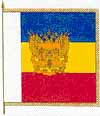 Section 13. The standard (flag) of the Head of Administration (Governor) of the Rostov Region is constantly located in the office of the Head of Administration (Governor) of the Rostov Region. The standard (flag) of the Head of Administration (Governor) of the Rostov region (or its proportionally reduced copy) is constantly with the Head of Administration (Governor) of the region during official events with his participation.
Section 13. The standard (flag) of the Head of Administration (Governor) of the Rostov Region is constantly located in the office of the Head of Administration (Governor) of the Rostov Region. The standard (flag) of the Head of Administration (Governor) of the Rostov region (or its proportionally reduced copy) is constantly with the Head of Administration (Governor) of the region during official events with his participation.
Section 14. The standard (flag) of the Head of Administration (Governor) of the Rostov Region should be reproduced in strict accordance with the image attached to this Law.
Section 15. The standard of the Standard (flag) of the Head of Administration (Governor) of the Rostov region in color is in the permanent exhibition of the regional museum of local lore.
Section 16. Violation of the Flag of the Rostov Region, as well as the image of the Flag of the Rostov Region, shall entail liability in accordance with the legislation of the Russian Federation.
The use of the Flag of the Rostov Region in violation of the requirements established by this Regional Law entails administrative responsibility in accordance with the Regional Law of October 25, 02, No. 273-ЗС “On Administrative Offenses”.
Section 17. This Law shall enter into force upon publication.
Head of the Administration of the Rostov Region V.F. Forelock
Hymn of the Rostov Region
It was created on the basis of F.I.Anisimov’s song “The Orthodox Quiet Flows the Don, was agitated,” written in 1853.
Orthodox Pacific Don
Stirred up, excited
Orthodox Pacific Don.
And dutifully responded
At the call of freedom he is.
The Don steppe turns green
Golden waves of cornfields.
And from the open, caressing the rumor,
Free call is heard.
Hail Don, and in our years
In memory of free antiquity,
In the hour of adversity - the honor of freedom
Your sons defend.
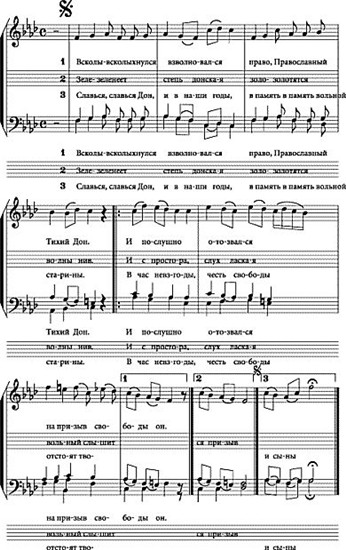
Regional law "On the anthem of the Rostov region"
Article 1 The anthem of the Rostov region is a symbol of the preservation of traditions and culture, the unity of the Rostov region.
To approve the text and the musical edition of the Anthem of the Rostov Region, created on the basis of the song by F.I. Anisimova "The Orthodox Quiet Don was excited, excited."
Section 2 The anthem of the Rostov region is performed during ceremonies and other events held by state authorities of the Rostov region;
When raising the Flag of the Rostov region;
After taking the oath of office by the newly elected Head of Administration (Governor) of the Rostov Region;
At the opening of monuments and commemorative signs;
When opening and closing meetings of the Legislative Assembly of the Rostov Region;
When opening and closing ceremonial meetings dedicated to holidays and memorable days.
Section 3. The anthem of the Rostov region is broadcast by the State TV and Radio Company Don-TR:
When broadcasting - before the broadcast of the television program of the State Television and Radio Company Don-TR during the holidays of the Rostov Region;
When broadcasting - daily before the broadcast of the first radio program of the State Television and Radio Company "Don-TR".
Section 4. The anthem of the Rostov Region may also be performed in other cases by decision of state authorities and local authorities, heads of enterprises, institutions, organizations, private individuals in compliance with the requirements of this Law.
Section 5. When conducting official events abroad, the performance of the Anthem of the Rostov Region is carried out in accordance with the rules of the diplomatic protocol and practice of the host country.
Section 6. It is allowed to perform the Anthem of the Rostov Region during sporting events.
Section 7. The anthem of the Rostov Region can be performed in an orchestra, choral, orchestra-choral or other vocal and instrumental performance. In this case, sound recording means can be used.
Partial anthem is allowed in instrumental performance - the chorus and chorus are played once.
Section 8. During the public performance of the Anthem of the Rostov Region, those present listen to it while standing, men - without hats.
Section 9. The anthem of the Rostov Region must be performed in strict accordance with the text and the music edition attached to this Law.
Section 10. Responsibility for non-compliance with the established requirements in the performance of the Anthem of the Rostov Region lies with the heads of state authorities, local authorities, enterprises, institutions and organizations conducting relevant events.
Section 11. This Law shall enter into force upon its publication.
COAT OF ARMS OF THE ROSTOV REGION
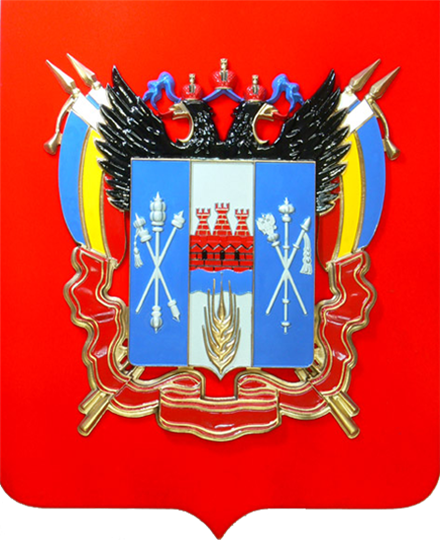 The coat of arms of the Rostov Region, which basically replicates the coat of arms of the Don Army region, was adopted by the Legislative Assembly on October 28, 1996. We give its description in the wording of the corresponding law of December 5, 1997. The coat of arms "... is a heraldic shield, in the azure (blue) field of which there is a silver pillar with a scarlet (red) fortified wall on the azure wavy belt about three towers, the middle one is higher; at the tip there is a golden spike covering the azure wavy belt.
The coat of arms of the Rostov Region, which basically replicates the coat of arms of the Don Army region, was adopted by the Legislative Assembly on October 28, 1996. We give its description in the wording of the corresponding law of December 5, 1997. The coat of arms "... is a heraldic shield, in the azure (blue) field of which there is a silver pillar with a scarlet (red) fortified wall on the azure wavy belt about three towers, the middle one is higher; at the tip there is a golden spike covering the azure wavy belt.
The column is accompanied by historical Don regalia: on the right - with a silver feather over silver silver tail and notches across; on the left - with a silver mace over the same insects with an eagle and a bunchuk crosswise.
Shield holder - a black double-headed eagle appearing above the shield with golden beaks and scarlet tongues, having a Russian imperial crown above each head and crowned in the middle with a large Russian crown with azure ribbons.
Behind the shield are four folded across the flag of the Rostov region on the gold flagpoles with spear tips, cords and tassels.
The famous poles are intertwined with the ribbon of the Order of Lenin. "
The fortress wall means that from the end of the XVI century the Don Cossack army guarded the southern borders of the Russian state, the azure wavy belt - the location of the Cossack settlement for hundreds of kilometers along the Don and its tributaries, the golden ear - a high level of development of grain farming in the region. On a blue field on both sides of the shield are symbols of the ataman authority. Mace - a wooden or metal stick with a ball on the end - a rod or a symbol of government among the Cossacks. Pernach and notch are varieties of mace. At the end of the pole, there was a head of ten or more metal feathers (hence the name), sometimes decorated with a ponytail. A notch is a stalk with a topping in the shape of a ball decorated with twisted grooves. The crown is crowned national emblem in the form of an eagle. Bunchuk was a decorated shaft with horseback tails planted. Bunchuk with a gilded ball, from which white hair hung, and a soaring eagle at the top was called the "filial tail".
The crowned double-headed eagle, a historical attribute of the coat of arms of the Army of the Don (Don) region, was granted the Don Army by Alexander 1 in 1803 and personified the connection with the empire.
REGIONAL LAW ON THE COAT OF ARMS OF THE ROSTOV REGION
Article 1 The coat of arms of the Rostov region is a symbol of the Rostov region.
Section 2 The coat of arms of the Rostov Region is a heraldic shield, in the azure (blue) field of which is a silver pillar with a scarlet (red) fortress wall placed on the azure wavy belt about three towers, of which the middle one is higher; at the tip - a golden spike covering the azure wavy belt. The column is accompanied by historical Don regalia: on the right - with a silver feather over silver silver tail and notches across; on the left - a silver mace over the same insects with an eagle and a bunchuk crosswise. Shield holder - a black double-headed eagle appearing above the shield with golden beaks and scarlet tongues, with a Russian imperial crown on each head and crowned in the middle with a large Russian crown with azure ribbons. Behind the shield are four folded across the flag of the Rostov region on the gold flag poles with spear tips, cords and tassels. The famous poles are intertwined with the ribbon of the Order of Lenin.
Section 3. Reproduction of the Coat of Arms of the Rostov Region in one-color version is allowed.
Section 4. Reproduction of the Coat of Arms of the Rostov Region is mandatory:
On the facade of the buildings of the Legislative Assembly and the Administration of the Rostov region.
In the offices of the chairman of the Legislative Assembly of the region, the Head of Administration (Governor) of the Rostov region, in the halls where meetings of the Legislative Assembly of the Rostov region are held, as well as in the ceremonial registration of births and marriages.
On the forms of documents and official seals of the Legislative Assembly of the Rostov Region, the Administration of the Rostov Region, regional administration bodies, as well as state-owned enterprises of regional ownership, regional state institutions and organizations.
On the Standard (flag) of the Head of Administration (Governor) of the Rostov region.
On the certificates of deputies of the Legislative Assembly of the Rostov region, official certificates of public servants, on the print media of the Legislative Assembly and the Administration of the Rostov region.
In the design of national and official holidays celebrated in the Rostov region.
Section 5. The coat of arms of the Rostov region can be reproduced in the form of sports teams and individual athletes defending the sports honor of the Rostov region.
Section 6. It is allowed to include the Coat of Arms of the Rostov Region (composition of the coat of arms) or its elements in the coats of arms of municipalities that are part of the Rostov Region. When a full composition of the coat of arms of the Rostov Region is placed in the Coat of Arms of the municipality, the latter is located in the free part (the quadrangular space adjacent to the upper left or right edge of the shield).
Section 7. The laws of the Rostov region may provide for other cases of compulsory reproduction of the image of the Coat of Arms of the Rostov Region.
Section 8. The reproduced image of the Coat of Arms of the Rostov Region, regardless of its size, must always exactly correspond to the heraldic description given in Article 2 of this Law.
Section 9. The image of the Coat of Arms of the Rostov Region in color and one-color author's performance is in a permanent exhibition of the regional museum of local lore.
Section 10. The procedure for the manufacture, use, storage and destruction of letterheads and seals with reproduction of the Coat of Arms of the Rostov Region is established by the Administration of the Rostov Region.
Section 11. This law shall enter into force upon publication.
Head of the Administration of the Rostov Region V. Chub
FLAG OF THE KAGALNITSKY DISTRICT
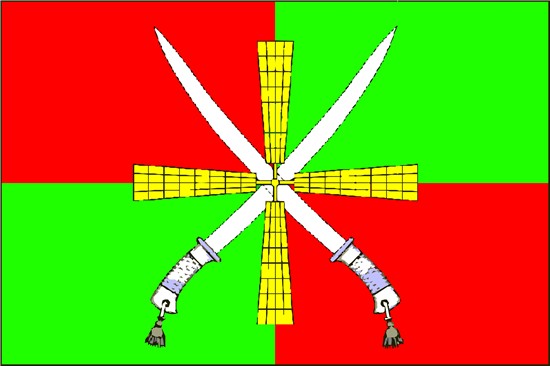
The flag of the Kagalnitsky region is a rectangular cloth with a ratio of width to length 2: 3, divided into four equal parts: at the top of the pole and the visu at the free edge - red, the rest - green; reproducing in the center of the figure from the stamped composition: yellow four-pointed wings of the mill in a cross over two white checkers crosswise. "
The village of Kagalnitskaya, the center of the district of the same name, is one of the oldest settlements located on the present Rostov-Stavropol route and has been known as a postal station since the beginning of the 17th century.
Checkers crosswise and the red parts of the flag allegorically symbolize the Don Cossacks. Like throughout the Don, the Kagalnitsky Cossacks were warriors, and they sought to convey the spirit of the lot in customs, in everyday life: one of the elements of the rite of initiation of the boy in the Cossacks is putting on a saber.
Red color means law, strength, love, courage, courage.
White color (silver) is a symbol of perfection, nobility, purity, faith, peace.
The main agricultural sectors of the region - grain and livestock, are shown by the wings of the mill and the green parts of the flag.
Yellow color (gold) is a symbol of the highest value, wealth, greatness, constancy. strength, generosity, intelligence and sunlight.
Green color also complements the symbolism of nature and symbolizes abundance, life. rebirth.
COAT OF ARMS OF THE KAGALNITSKY DISTRICT
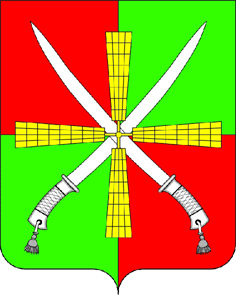
The heraldic description of the coat of arms of the Kagalnitsky region reads:
“In a quadruple field divided by a scarlet (red) and greenery, the golden four-pointed wings of the mill cross to the top on top of two silver pieces”
3.2. The coat of arms of the Kagalnitsky district, in accordance with the Law of the Rostov Region dated December 5, 1997 No. 47-ЗС “On the coat of arms of the Rostov Region”, can be reproduced in two equally acceptable versions:
With the free part - (a quadrangular space adjacent to the upper left or right edge of the shield) with the complete composition of the coat of arms of the Rostov region placed in it;
Without free part and.
3.3. Justification of the symbolism of the coat of arms of the Kagalnitsky region.
The village of Kagalnitskaya, the center of the district of the same name, is one of the oldest settlements located on the present Rostov-Stavropol route and has been known as a postal station since the beginning of the 17th century.
Checkers crosswise and the red parts of the coat of arms allegorically symbolize the Don Cossacks. Like throughout the Don, the Kagalnitsky Cossacks were warriors, and they sought to convey this spirit in customs, in everyday life: one of the elements of the rite of initiation of the boy in Cossacks is putting sabers on him.
Red color means law, strength, love, courage, courage. Silver is a symbol of perfection, nobility, purity, faith, peace. The main agricultural sectors of the region - grain and livestock are shown by the wings of the mill and the green part of the coat of arms.
Gold is a symbol of the highest value, wealth, greatness, constancy, strength, generosity, intelligence and sunlight.
Green color also complements the symbolism of nature and symbolizes abundance, life is rebirth.
The administrative-territorial affiliation of the Kagalnitsky district to the Rostov region, according to the Law of the Rostov region dated December 5, 1997 No. 47-ЗС “On the coat of arms of the Rostov region”, can be indicated by placing in the coat of arms of the municipality “Kagalnitsky district” a free part - a quadrangular space from the inside to the upper edge of the shield with the full composition of the coat of arms of the Rostov region reproduced in it.
coat of arms idea: Alexander Kravtsov (st. Kagalnitskaya)
heraldic revision: Konstantin Mochenov (Khimki)
justification of symbolism: Galina Tunik (Moscow)
computer design: Sergey Isaev (Moscow).
- The training system according to the Dalton plan - the organization of the educational process - Sergei V. Sidorov
- Internal differences, specialization of individual cities
- Consonant and letter th
- Not a single word: whom to work after philology
- Warning flags on the beach
- Abstract of speech therapy classes in elementary school
- Sound and Alpha Word Analysis

 Live journal
Live journal Facebook
Facebook Twitter
Twitter